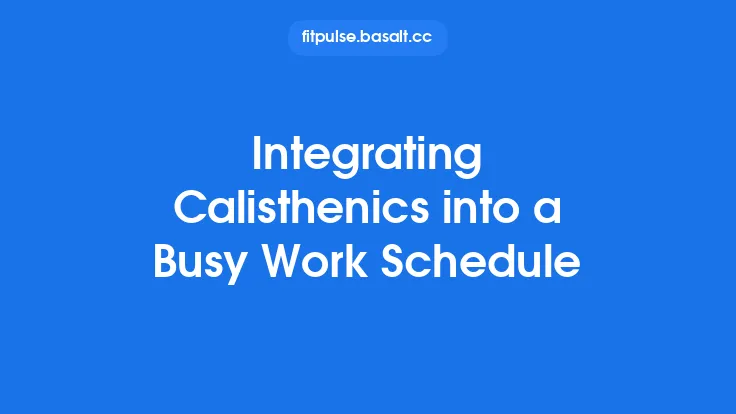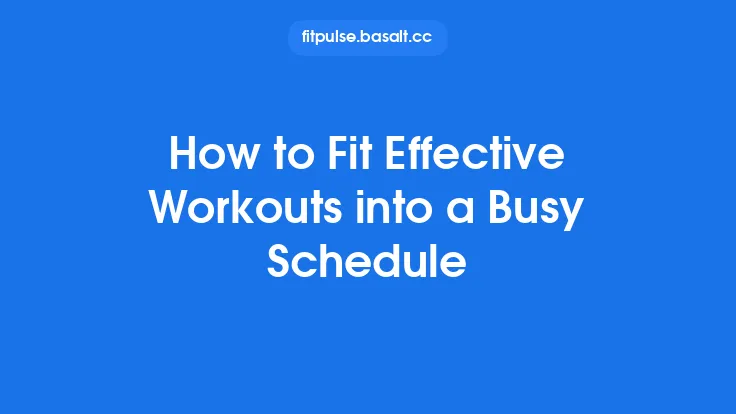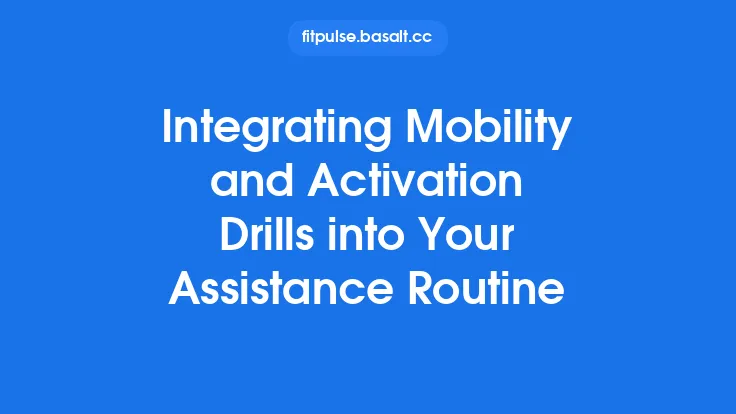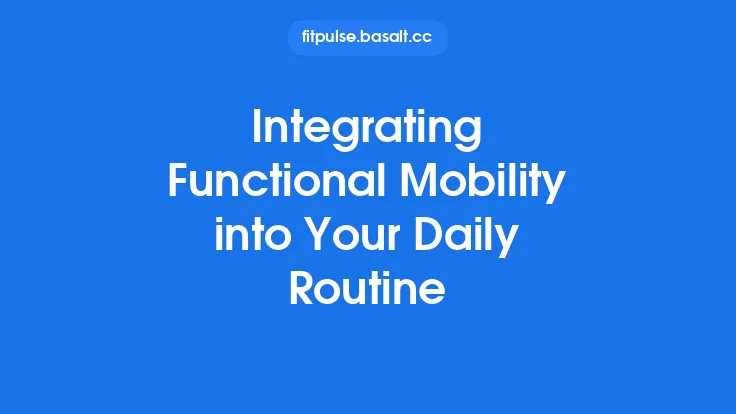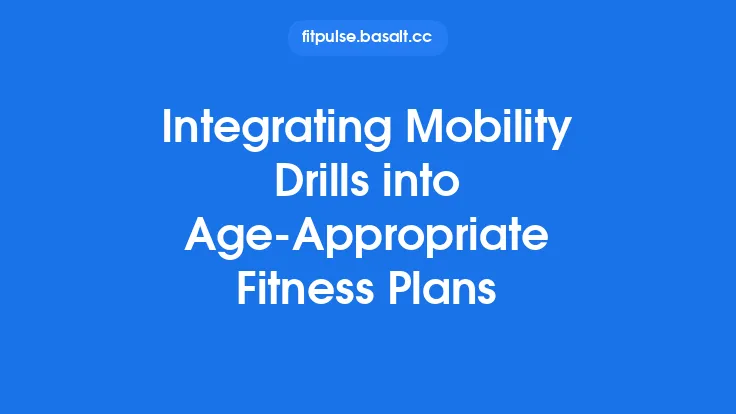Integrating mobility work into a demanding office routine is less about finding a handful of isolated stretches and more about weaving purposeful movement into the fabric of the workday. When approached strategically, mobility exercises become a catalyst for sustained energy, sharper focus, and long‑term musculoskeletal health—without sacrificing productivity or professional responsibilities.
Why Mobility Matters in the Office Environment
Mobility, defined as the ability of joints and surrounding tissues to move through their full range of motion, underpins virtually every physical task we perform, from typing and reaching for a file to walking between conference rooms. In a typical office setting, prolonged periods of static posture lead to adaptive shortening of muscles, reduced joint lubrication, and diminished proprioceptive feedback. Over time, these changes can manifest as reduced work efficiency, increased fatigue, and a heightened risk of injury.
Beyond the physical, mobility influences cognitive performance. Research in occupational health shows that brief, intentional movement can stimulate cerebral blood flow, elevate neurotransmitter levels, and reset the autonomic nervous system, thereby improving concentration and decision‑making capacity. In high‑pressure environments where mental acuity is paramount, mobility becomes a performance enhancer rather than a peripheral wellness add‑on.
Assessing Your Current Mobility Landscape
Before embedding new practices, it is essential to understand the baseline state of movement within the organization:
| Assessment Tool | What It Measures | How to Implement |
|---|---|---|
| Self‑Report Mobility Questionnaire | Perceived joint stiffness, frequency of movement breaks, and pain levels | Distribute digitally; anonymize to encourage honesty |
| Objective Range‑of‑Motion Screening | Quantifiable joint angles using goniometers or smartphone apps | Conduct quarterly during wellness days |
| Work‑Pattern Analysis | Duration of uninterrupted sitting, meeting frequency, and task cycles | Leverage calendar data and time‑tracking software |
| Productivity Metrics Correlation | Links between movement frequency and output (e.g., task completion time) | Integrate with existing performance dashboards |
Collecting this data creates a clear picture of where mobility deficits exist and which departments or roles are most at risk. It also provides a benchmark for future improvement.
Designing a Scalable Mobility Integration Plan
A successful plan balances three core pillars: frequency, duration, and intensity. Rather than prescribing a one‑size‑fits‑all routine, the plan should be modular, allowing teams to adopt components that align with their workflow.
- Frequency – Aim for multiple movement “anchor points” throughout the day (e.g., start of the day, post‑lunch, pre‑meeting).
- Duration – Allocate 5–10 minutes per anchor point for focused mobility work, which can be extended during slower periods.
- Intensity – Begin with low‑load, joint‑centric drills and progress to higher‑load, functional mobility sequences as tolerance improves.
A tiered framework (Basic, Intermediate, Advanced) enables employees to graduate as confidence and capacity grow, fostering a sense of achievement and encouraging continued participation.
Leveraging Calendar Blocks and Meeting Structures
Modern office calendars are powerful tools for habit formation. By treating mobility sessions as non‑negotiable appointments, you embed them into the same cognitive hierarchy as client calls or project deadlines.
- Pre‑Meeting Mobility Warm‑Up – Reserve 5 minutes before a scheduled meeting for a joint‑circulation routine. This not only prepares the body but also sharpens mental focus for the discussion ahead.
- Post‑Lunch Reset – Block a short slot after lunch to counteract post‑prandial sluggishness. A mobility sequence that emphasizes hip flexor extension and thoracic rotation can re‑energize the nervous system.
- End‑of‑Day Release – Conclude the workday with a mobility “cool‑down” that promotes circulation and prepares the body for recovery.
Encourage managers to model this behavior by visibly scheduling their own mobility blocks, thereby normalizing the practice across hierarchical levels.
Embedding Mobility into Workflow Milestones
Beyond calendar slots, mobility can be tied directly to task completion milestones:
- Document Review Pause – After finalizing a report, perform a brief mobility circuit before moving on to the next task.
- Code Commit Break – Software developers can integrate a short mobility set after each major code push, reducing the cumulative strain of prolonged typing.
- Client Presentation Transition – Use the interval between presentations to execute a mobility flow that re‑sets posture and breath.
By linking movement to concrete work outcomes, employees perceive mobility as a functional component of productivity rather than an optional distraction.
Utilizing Office Spaces and Resources
Physical environment plays a pivotal role in facilitating movement:
- Designated Mobility Zones – Convert underused conference rooms or quiet corners into “movement studios” equipped with yoga mats, resistance bands, and foam rollers.
- Mobile Equipment Carts – Deploy carts stocked with portable mobility tools that can be wheeled to any floor, ensuring accessibility for remote or satellite teams.
- Adjustable Workstations – While standing desks are a separate topic, providing height‑adjustable tables that allow for seated‑to‑standing transitions supports a broader range of mobility activities.
When spaces are intentionally curated for movement, employees are more likely to engage spontaneously throughout the day.
Technology‑Enabled Mobility Tracking
Digital platforms can reinforce habit formation and provide data for continuous improvement:
- Mobile Apps with Guided Sessions – Offer a curated library of mobility modules that employees can follow at their own pace. Integration with corporate single sign‑on (SSO) simplifies access.
- Wearable Sensors – Use devices that monitor posture, step count, and sedentary time. Automated alerts can prompt users to initiate a mobility break when thresholds are exceeded.
- Analytics Dashboards – Aggregate anonymized usage data to identify trends, high‑adoption teams, and areas needing additional support. Share insights in quarterly wellness reports to maintain transparency and motivation.
Technology should serve as an enabler, not a replacement for the human element of movement.
Building a Culture of Movement
Sustainable integration hinges on cultural acceptance:
- Leadership Endorsement – Executives who publicly participate in mobility sessions signal organizational commitment.
- Peer‑Led Mobility Ambassadors – Identify enthusiastic employees to champion movement, lead group sessions, and share personal success stories.
- Gamified Challenges – Create friendly competitions (e.g., “most consistent mobility streak”) with non‑monetary rewards such as extra break time or recognition in company newsletters.
- Education Sessions – Host quarterly workshops that explain the science behind mobility, demonstrate proper technique, and address common misconceptions.
When movement is celebrated as a core value, participation becomes a natural extension of daily work life.
Tailoring Mobility for Different Job Functions
Not all roles experience the same movement constraints. Customization ensures relevance:
| Role | Typical Constraints | Suggested Mobility Focus |
|---|---|---|
| Administrative Staff | Extended desk time, repetitive keyboard use | Wrist, forearm, and thoracic mobility |
| Sales Representatives | Frequent travel, variable work locations | Hip flexor, ankle, and core stability |
| Engineers/Developers | Long periods of seated coding | Hip, lumbar, and scapular mobility |
| Customer Service | High vocal demand, static posture | Diaphragmatic breathing, cervical‑thoracic mobility |
| Facilities Management | Physical labor interspersed with desk work | Full‑body functional mobility, grip strength |
Providing role‑specific guidelines helps employees see immediate relevance, increasing adherence.
Progressive Mobility Programming and Periodization
Just as athletes periodize training to avoid plateaus, office mobility programs benefit from structured progression:
- Foundation Phase (Weeks 1‑4) – Emphasize joint articulation and soft‑tissue preparation. Low‑load movements, high repetitions.
- Development Phase (Weeks 5‑12) – Introduce controlled loading (e.g., resistance bands, light kettlebells) to enhance joint stability and muscular endurance.
- Performance Phase (Weeks 13‑20) – Incorporate functional mobility circuits that mimic work‑related movements, such as reaching, twisting, and load transfer.
- Maintenance Phase (Beyond Week 20) – Cycle between phases to prevent stagnation, adjusting intensity based on individual feedback and performance metrics.
Periodization keeps the program dynamic, reduces monotony, and aligns mobility work with broader organizational cycles (e.g., fiscal quarters, project sprints).
Evaluating Impact and Adjusting the Plan
Continuous evaluation ensures the program delivers tangible benefits:
- Quantitative Metrics – Track reductions in reported musculoskeletal discomfort, absenteeism rates, and changes in productivity indices.
- Qualitative Feedback – Conduct focus groups and pulse surveys to capture employee sentiment, perceived barriers, and suggestions for improvement.
- Iterative Refinement – Use data to tweak frequency, duration, or content. For example, if post‑lunch mobility uptake is low, experiment with a shorter “reboot” session or integrate it into a communal lunch break activity.
A feedback loop demonstrates organizational responsiveness and reinforces employee investment in the program.
Common Pitfalls and How to Overcome Them
| Pitfall | Why It Happens | Mitigation Strategy |
|---|---|---|
| Viewing Mobility as “Extra Work” | Competing priorities and tight deadlines | Position mobility as a productivity enhancer; embed it within existing tasks rather than adding separate obligations. |
| One‑Size‑Fits‑All Programming | Lack of role‑specific insight | Conduct role analyses and develop modular content that can be mixed and matched. |
| Inconsistent Leadership Modeling | Managers forget to schedule their own mobility time | Implement automated calendar prompts for leaders and recognize mobility champions in performance reviews. |
| Insufficient Space or Equipment | Budget constraints or office layout | Leverage multipurpose areas, use low‑cost tools (e.g., resistance bands), and encourage “desk‑adjacent” mobility that requires minimal space. |
| Neglecting Data‑Driven Adjustments | Relying on anecdotal success | Establish a baseline measurement system and schedule quarterly data reviews. |
Proactively addressing these challenges prevents attrition and sustains long‑term engagement.
Conclusion: Sustainable Mobility Integration
Embedding mobility exercises into a bustling office schedule is a strategic investment in human capital. By treating movement as an integral component of workflow—anchored in calendar blocks, tied to task milestones, supported by dedicated spaces, and reinforced through technology and culture—organizations can cultivate a resilient, high‑performing workforce. The approach outlined here moves beyond isolated stretches or quick fixes; it establishes a living, adaptable system that evolves with the organization’s needs, ensuring that mobility remains a permanent, valued facet of the modern workplace.
